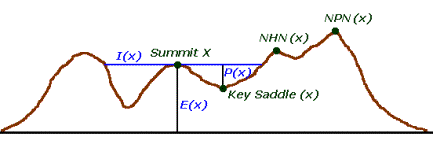
| Back to Table of Contents | Back to Theory Page |
Isolation
is a fun conceptual tool, somewhat independent of prominence theory. Isolation is the measure, proposed by
Greg Slayden, of the distance in miles from a summit to anything higher.
Say
that you were standing on a summit as the sea level rises around you. At the point that the rising ocean
reaches the summit on which you stand, how far would you have to swim
to reach
the first speck of dry land?
That dry land may be on the slope of your summit's next-higher
neighbor, or it
may in an entirely different direction.
Isolation need not equate to the distance across a key saddle,
as shown
in the following figure, where I(x) equals the isolation value for
Summit
X. Isolation corresponds to the
radius of the largest circle for which a summit is the highest point. All summits, except Mt. Everest, have
an isolation value.

Greg
Slayden and Aaron Maizlish researched the isolation of summits in
contiguous
United States and found 41 peaks with an isolation value of 100 miles
or
more. Worldwide, Greg has found 42
peaks with 1,000+ miles of isolation; a list that correlates somewhat
to the list of high prominence mountains, but with the inclusion of
several low summits on remote islands or in low-relief parts of the
world. Extensive isolation tables can be found at www.peakbagger.com. This
would be a good completion list for the truly cluastrophobic.
TABLE:
WORLD SUMMITS WITH AT LEAST 1,000 MILES ISOLATION
provisional
list
by Greg Slayden
| Rk. |
Summit |
High
Point of... |
Isolation
Value (miles) |
| 1. |
Mt. Everest |
HP World |
not
applicable |
| 2. |
Aconcagua |
HP The Americas |
10267 |
| 3. |
Mt. McKinley |
HP North America |
4631 |
| 4. |
Kilimanjaro |
HP Africa |
3503 |
| 5. |
Puncak Jaya |
HP New Guinea |
3266 |
| 6. |
Vinson Massif |
HP Antarctica |
3066 |
| 7. |
Mont Orohena |
HP Tahiti |
2566 |
| 8. |
Mauna Kea |
HP Hawaii |
2453 |
| 9. |
Gunnbjørn Fjeld |
HP Greenland |
2022 |
| 10. |
Mt. Cook |
HP New Zealand |
1951 |
| 11. |
Thabana Ntlenyana |
HP Lesotho (Southern
Africa) |
1871 |
| Maunga Terevaka |
HP Easter Island |
1763 |
|
| 12. |
Mont Blanc |
HP France |
1751 |
| 13. |
Piton des Neiges |
HP Reunion |
1720 |
| 14. |
Klyuchevskaya Sopka |
HP Kamchatka Peninsula |
1713 |
| 15. |
Pico de Orizaba |
HP Mexico |
1670 |
| 16. |
Queen Mary's Peak |
HP Saint Helena |
1659 |
| 17. |
Mt. Whitney |
HP California (Lower 48) |
1647 |
| 18. |
Kota Kinabalu |
HP Borneo |
1568 |
| 19. |
Pico de Bandeira |
HP Brazilian Highlands |
1493 |
| 20. |
Mt. Cameroun |
HP Cameroon (West Africa) |
1453 |
| 21. |
Mt. Paget |
HP South Georgia Island |
1410 |
| 22. |
Mauga Silisili |
HP Samoa |
1394 |
| 23. |
Nevado Huascarán |
HP Peru |
1365 |
| 24. |
Anai Mudi |
HP Ghats, India |
1338 |
| 25. |
Jebel Toubkal |
HP Atlas, Morocco |
1292 |
| 26. |
Mt. Fuji |
HP Japan |
1277 |
| 27. |
Emi Koussi |
HP Chad |
1244 |
| 28. |
Yu Shan |
HP Taiwan |
1230 |
| 29. |
Mawson Peak |
HP Heard Island (Indian
Ocean) |
1194 |
| 30. |
Mt. Mitchell |
HP Eastern United States |
1189 |
| 31. |
Gunung Kerinci |
HP Sumatera |
1187 |
| 32. |
Agrihan High Point |
HP Northern Marianas |
1181 |
| 33. |
Mt. Kosciuszko |
HP Australia, continental |
1178 |
| 34. |
Moro de Moco |
HP Angola |
1154 |
| 35. |
Olavtoppen |
HP Bouvetoya (South
Atlantic island) |
1154 |
| 36. |
Jarvis High Point |
HP Jarvis Island (Central
Pacific) |
1151 |
| 37. |
Swart Peak |
HP Prince Edward Island
(South Indian Ocean) |
1148 |
| 38. |
Green Mountain |
HP Ascension Island |
1145 |
| 39. |
Gora Narodnaya |
HP Urals, Russia |
1141 |
| 40. |
Damavand |
HP Iran |
1101 |
| 41. |
Pico de Cano |
HP Cape Verde |
1042 |
| 42. |
Mt. Liebig |
HP Northern Territory,
Australia |
1016 |
Isolation,
of course, correlates pretty well to prominence and to lists of high
points of
political entities, as they measure different aspects of the same
phenomenon, a
vertical protuberance on the earth's surface. Prominence
is purely a height function, and isolation is
purely a distance function.
Low
mid-oceanic islands can have high isolation values and low prominence,
as
evidenced by the appearance of Tristan da Cunha and Easter
Island on
the worldwide list. The U.S. list
has some isolated low rises too:
Sugarloaf Mtn., the high point of the central Florida peninsula
(E=311,
P=275)
is the twelfth most isolated "summit" in the U.S. at 211
miles.
Of
the 40 most isolated summits in the U.S., 20 are also among the 57 most
prominent (P>5,000'), and 29 have P>2,000'. 19
of the 41 are also state highpoints.
(End of
essay, for now)
| Back to Table of Contents | Back to Theory Page |